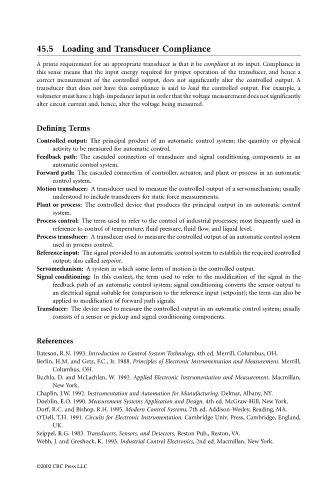Page 1183 - The Mechatronics Handbook
P. 1183
45.5 Loading and Transducer Compliance
A prime requirement for an appropriate transducer is that it be compliant at its input. Compliance in
this sense means that the input energy required for proper operation of the transducer, and hence a
correct measurement of the controlled output, does not significantly alter the controlled output. A
transducer that does not have this compliance is said to load the controlled output. For example, a
voltmeter must have a high-impedance input in order that the voltage measurement does not significantly
alter circuit current and, hence, alter the voltage being measured.
Defining Terms
Controlled output: The principal product of an automatic control system; the quantity or physical
activity to be measured for automatic control.
Feedback path: The cascaded connection of transducer and signal conditioning components in an
automatic control system.
Forward path: The cascaded connection of controller, actuator, and plant or process in an automatic
control system.
Motion transducer: A transducer used to measure the controlled output of a servomechanism; usually
understood to include transducers for static force measurements.
Plant or process: The controlled device that produces the principal output in an automatic control
system.
Process control: The term used to refer to the control of industrial processes; most frequently used in
reference to control of temperature, fluid pressure, fluid flow, and liquid level.
Process transducer: A transducer used to measure the controlled output of an automatic control system
used in process control.
Reference input: The signal provided to an automatic control system to establish the required controlled
output; also called setpoint.
Servomechanism: A system in which some form of motion is the controlled output.
Signal conditioning: In this context, the term used to refer to the modification of the signal in the
feedback path of an automatic control system; signal conditioning converts the sensor output to
an electrical signal suitable for comparison to the reference input (setpoint); the term can also be
applied to modification of forward path signals.
Transducer: The device used to measure the controlled output in an automatic control system; usually
consists of a sensor or pickup and signal conditioning components.
References
Bateson, R.N. 1993. Introduction to Control System Technology, 4th ed. Merrill, Columbus, OH.
Berlin, H.M. and Getz, F.C., Jr. 1988. Principles of Electronic Instrumentation and Measurement. Merrill,
Columbus, OH.
Buchla, D. and McLachlan, W. 1992. Applied Electronic Instrumentation and Measurement. Macmillan,
New York.
Chaplin, J.W. 1992. Instrumentation and Automation for Manufacturing. Delmar, Albany, NY.
Doeblin, E.O. 1990. Measurement Systems Application and Design, 4th ed. McGraw-Hill, New York.
Dorf, R.C. and Bishop, R.H. 1995. Modern Control Systems, 7th ed. Addison-Wesley, Reading, MA.
O’Dell, T.H. 1991. Circuits for Electronic Instrumentation. Cambridge Univ. Press, Cambridge, England,
UK.
Seippel, R.G. 1983. Transducers, Sensors, and Detectors. Reston Pub., Reston, VA.
Webb, J. and Greshock, K. 1993. Industrial Control Electronics, 2nd ed. Macmillan, New York.
©2002 CRC Press LLC

